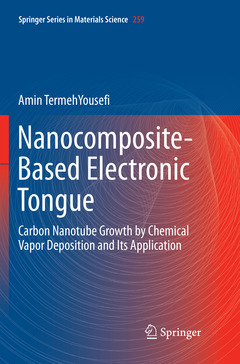Nanocomposite-Based Electronic Tongue, 1st ed. 2018 Carbon Nanotube Growth by Chemical Vapor Deposition and Its Application Springer Series in Materials Science Series, Vol. 259
Auteur : TermehYousefi Amin

Introduction.- Literature Review.- Experimental Procedures and Materials.- Results and Discussions.- Conclusions.
Dr. Amin TermehYousefi is a visiting research scholar and his research interests are in the areas of synthesis carbon nanomaterials (CNTs, graphene oxide, 3D graphene and graphene nanoribbons) as well as conductive polymers (polypyrrole and polyaniline) to fabricate electrochemical and electromechanical sensors. Besides, Dr. Amin has developed his research to brain-like circuits, single-walled carbon nanotube-atomic force microscopy tips, artificial fingers and artificial fingers based on haptic sensors.
Date de parution : 08-2018
Ouvrage de 101 p.
15.5x23.5 cm
Date de parution : 11-2017
Ouvrage de 101 p.
15.5x23.5 cm
